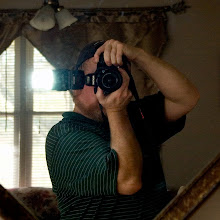There is something special about the intense inspiration some artists feel when they are in a fresh location. If that location happens to be an exotic foreign land, that's even better. Travel is good for the soul and your portfolio. A friend of mine is planning a vacation in Mexico. This has inspired me to write a short blog with tips for the traveling photographer. So I hope this helps you the next time you're getting ready to go on a vacation. A bit of prep time will help you take lots of wonderful photographs while having a safe and fun adventure.
Make sure your equipment is in good working order. Take a few pictures a couple of days before you leave and look at them zoomed in close in your image editing software (i.e. iphoto or Photoscape). Check to be sure you've charged up any extra batteries you carry. Some of the newer rechargeables don't hold power well if they sit unused for long periods of time. If you're going to be in a different country, be sure you have whatever adapters you'll need to recharge your batteries on a foreign power grid. Don't forget to take plenty of memory cards (they're really cheap these days) and format all of your memory cards before you leave. Make sure you've transferred all your old files to your computer first, of course.
Check to see that your lens is nice and clean. The trick to cleaning your lens is to never get it dirty (no kidding). Don't freak out if you do have to clean the lens with a few drops of fluid and a microfiber cloth, but remember to be very gentle and that at the microscopic level you are scratching your lens every time you have to clean it this way. It doesn't hurt the lens to gently dust it off with a soft camel hair brush or very lite, short burst of compressed air. If you're an environmentalist, the brush is your best bet.
If you are aware of particular sites where you are especially interesting in doing some photography, you can go on Google Earth and zoom in to see just how the site where you wish to photograph is oriented by the compass. Once you know what direction you'll be facing when you make your exposures, you can easily determine when the sun is going to be behind you giving you the very best lighting conditions for your photograph. Now this may be a bit more work than you were thinking of doing, but if you try it for one site this trip and see how amazing your photos look you'll want to do this for multiple sites the next time you travel. When you composs your images, try and make sure you get your horizons level and leave a little room so you can crop the image latter. If the image isn't perfectly level, you can adjust it latter as long as you leave yourself a bit of extra space around your subject.
Most scenic photographs are made early in the morning and late in the afternoon when the light is warm (yellow) and the shadows are long. I like to shoot scenic images with the my camera set on the "A" (aperture priority) mode. If it's a bright sunny day I set the camera on ISO 100. On an overcast day I'll use ISO 400. Unless you have a brand new camera, ISO settings above 400 will result in digital "noise" (tiny specks of random color) in the darkest shadows in your photograph. You can fix that in post processing, but try to keep your editing chores to a minimum by avoiding noise in the capture. Once you have the ISO set, increase the aperture to the highest setting possible while keeping the shutter-speed high enough to prevent blur. On an 18-55mm lens, 1/60s should be fast enough for still subjects. If you use a longer lens, you'll need to use a faster shutter-speed. Take the highest number of the focal length (i.e. 200 on a 55-200mm) and enter it as x in the equation 1/x. The closest shutter-speed to the result should be safe for making sharp images.
When taking pictures of people, most pros like to use flash even outdoors in broad daylight. The flash will open up any shadows on your subjects and add "catchlights" (tiny white reflections) to add a "sparkle" to their eyes. Don't forget to check all of your camera's basic settings and return anything that is awry to it's proper setting. Not doing this can lead to truly nasty surprises latter. One final thing to remember is that when you are shooting over water or snow the bright scene will trick the camera's light meter causes your pictures to come out too dark. Most digital camera's have a EV+/- control for exposure adjustments. Settings of +1 or just a bit higher will usually give you the results you want.
With a little preparation, you can enjoy your trip with no worries that your photographs won't come out the way you plan. Your memories will be even more special to you when you look at your own high quality photographs that remind you of the all fun you had and the wonderful sites you visited.
Happy Shooting :-)
Al Williams
Saturday, February 27, 2010
Subscribe to:
Post Comments (Atom)

Al,
ReplyDeleteThanks for the nice tips.